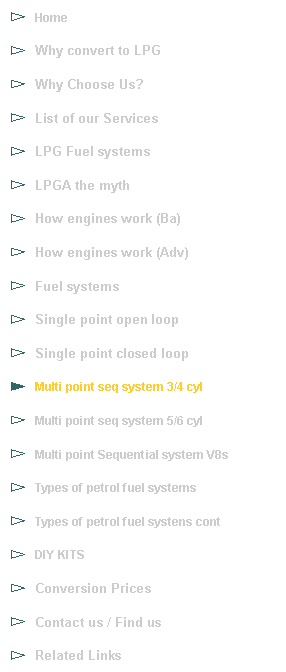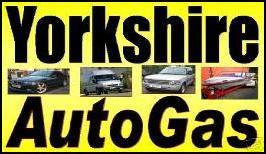


|
Picture of a sequential system dash mounted petrol / LPG changeover button incorporating LPG fuel gauge. |
|
Our multi-point fully sequential systems, known as third generation systems, are much more advanced than the earlier single point open and closed loop systems. Other installers may say they have fourth generation systems available but actually there is no such system as a fourth generation. This is the most advanced third generation system available. Designed for use on modern multi-point fuel injected vehicles, our systems are the epitome of LPG technology and offer the best performance and economy available by mirroring the way a modern vehicle’s multipoint sequential petrol injection system works. Our multipoint sequential systems are widely recognised as the best available, and come at a cost premium to us - a cost we do not pass on to our customers (we know we make less profit per vehicle than most other convertors as a greater proportion of the money for a conversion goes on these expensive high quality parts). They keep emissions well within the EURO4 standards and fully comply with the latest gas safety standards (67R01 and R110).
This system is suitable for electronic multipoint petrol injection systems of 3 or 4 cylinders (most vehicles), with or without a catalytic convertor. If your vehicle has more than 4 cylinders please see the correct section of this website for your vehicle’s number of cylinders.
Automatic
The combined changeover switch and fuel gauge (pic above) fitted inside the vehicle on these systems is about 20mm by 20mm. A row of LED lights indicate how full the LPG fuel tank is. The manual switch to change between running on LPG and petrol is a simple touch button that toggles between the two fuels whenever you wish. You do not even have to operate this button as, if left in LPG mode, the system switches between petrol and LPG (and vice/versa should you run out of LPG) automatically. If the system is left in LPG mode, the vehicle will start on petrol and switch to LPG when the engine is warm enough (under a minute usually for a flat cold engine). If you are running on LPG and run out of LPG fuel, the system will switch back to petrol automatically and alert you that you are running on expensive petrol by beeping and flashing the LED lights until you press the button to cancel the alert. Should you wish to start on LPG, this can be achieved by turning on the vehicle ignition and holding the button as you turn the key to crank the engine.
Tech stuff
It is advised you simply leave the button in automatic mode as this will ensure your petrol injectors will get a little use every time you start the engine. This prevents lacquers building up on your petrol injectors which could otherwise in time impede the petrol injectors and effect performance when running on petrol. Leaving the system in auto-mode also ensures the engine is warm enough to allow the vaporiser to do its job of converting the liquid LPG in the tank into a low pressure gaseous form for use by the LPG injectors. You will appreciate why the vaporiser must be warm if you have ever burst an aerosol can or cigarette lighter containing a similar gas - the gas escapes quickly at first but the rapid evaporation cools the contents and the cold gas then evaporates much more slowly.
These systems are fully and very fine tunable. Using specialist instruments we calibrate them to very exacting levels at all points across the entire engine speed and load curves. They have an advanced ECU which works in conjunction with a vehicle’s original petrol ECU. When running on LPG, the ECU monitors the signals from the original petrol ECU and applies the calibration settings set by us before sending these signals to the LPG injectors. This is necessary because, although LPG has similar properties to petrol, there are differences which require the injection time signals from the petrol ECU to be adjusted for the correct operation on LPG. It is also necessary because unlike petrol which is a liquid and therefore un-compressible, LPG gas is compressible. The LPG ECU can take into account the pressure and temperature of the gaseous LPG to ensure it injects the correct mass of LPG - Burning fuel is a chemical reaction, chemical reactions depend on the mass of chemicals involved rather than volumes.
The main system parts comprise of the LPG tank(s), fill point, vaporiser (reducer), fuel rail(s), injectors, LPG pressure and temperature sensors, engine vacuum sensors, ECU unit (computer), various valves / solenoids, piping and wiring.
The LPG tank supplies the vaporiser (reducer) with high pressure liquid LPG. The vaporiser turns the LPG into a lower pressure gas at a pressure between 0.9 and 1.7 bar above atmosphere (depending on application and specific parts fitted). The pressure is kept almost constant at this level above engine inlet manifold pressure by the vaporiser, even if turbo(s) or supercharger(s) are fitted. The gaseous LPG from the vaporiser goes to the fuel rails(s) where the LPG injector solenoids are located. There is an injector solenoid for each engine cylinder. Controlled by the LPG ECU, these injector solenoids are switched on and off individually and very fast (similarly to petrol injectors) and for a calculated and calibrated amount of time, to allow a highly controlled quantity of gaseous LPG to flow to the LPG injectors which are placed very close to the vehicle’s original petrol injectors. Working on signals from the vehicle’s original ECU, LPG pressure and temperature sensors, engine RPM, engine load (calculated from inlet manifold pressure), and calibration information, the LPG ECU finely controls the amount of LPG injected and also follows the vehicle’s original injection sequence. To the driver and all vehicle systems, including the original petrol ECU, LPG operation seems no different to running on petrol - something that cannot always be said for lesser systems which can often cause engine warning lights and ’limp home modes’ to be activated. During calibration, which can be checked and adjusted at any time by us, we have a number of ways of ensuring that we calibrate the system properly, including the system’s inbuilt exhaust emission level monitoring systems and petrol ECU signal monitoring functions.
|
|
Picture above are of a sequential system vaporiser, 4 cylinder fuel rail and ECU, and an inline LPG filter |
|
Multipoint Sequential: 3/4 cylinders |
|
Very high quality fully sequential system (3rd generation) Suitable for electronic fuel injection vehicles of 3 or 4 cylinders There are a lot more parts to this system than in the picture! This system suits the majority of vehicles on British roads. |








|
Saving motorists around 50% on petrol Site Updated January 2012 |